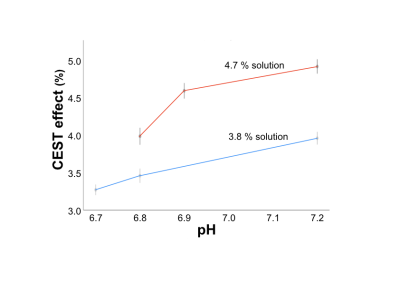S46
APT-CEST for pH imaging; a phantom study using egg white powder1Division of Radiology and Nuclear Medicine, Sapporo Medical University Hospital, Sapporo, Japan
Synopsis
We examined whether APT-CEST can reflect the difference of pH in solutions using egg white powder (EWP) using a 3-Tesla MRI. EWP was dissolved in distilled water to various concentrations, and their pH levels were subsequently titrated to 6.7-7.2. CEST effect (%)/ pH in 3.8 % solution were 3.27 ± 0.11/ 6.7, 3.46 ± 0.14/ 6.8 and 3.95 ± 0.11/ 7.2. CEST effect (%)/ pH in 4.7 % solution were 3.97 ± 0.17/ 6.8, 4.56 ± 0.15/ 6.9 and 4.88 ± 0.14/ 7.2. The solution using EWP can be used as a phantom reflecting the difference of pH in APT-CEST.
Background and Purpose
Amide proton Transfer-Chemical exchange saturation transfer MRI (APT-CEST) is imaging technique using contrast by exploiting the exchange between the hydrogen atoms of water and the amide hydrogen atoms of endogenous mobile cellular proteins and peptides [1]. APT-CEST enables to provide indirectly concentration of amide protons and proton exchange rate [2, 3]. In addition, the exchange directly depends on pH. Therefore, previous studies have reported APT-CEST as pH-weighted MRI. In the past phantom studies, several different metabolites have been used for APT-CEST [4, 5]. We focused on egg white powder as metabolite because of low cost and looking easy to adjust pH and solution concentration. The purpose of this study was to examine whether APT-CEST can reflect the difference of pH in a solution using egg white powder.Methods
Egg white powder was dissolved in distilled water to various concentrations (3.8 %, 4.7 %), and their pH levels were subsequently titrated to 6.7-7.2. A 3-Tesla MRI system (Ingenia; Philips Healthcare) was used for data acquisition in the present study. Scanning of APT-CEST (Saturation B1 rms/ Saturation duration, 2 μT/ 2 s) was repeated at three times with repositioning phantom. Furthermore, we calculated the average and standard deviations of CEST effects. We investigated the relationship between pH value and CEST effect.Results
CEST effect (%)/ pH in 3.8 % solution were 3.27 ± 0.11/ 6.7, 3.46 ± 0.14/ 6.8 and 3.95 ± 0.11/ 7.2. CEST effect (%)/ pH in 4.7 % solution were 3.97 ± 0.17/ 6.8, 4.56 ± 0.15/ 6.9 and 4.88 ± 0.14/ 7.2. CEST effect was increased with increasing of pH value.Conclusion
The solution using egg white powder can be used as a phantom reflecting the difference of pH in APT-CEST.Acknowledgements
No acknowledgement found.References
1. Zhou J Y, Payen J F, Wilson D A, et al. Using the amide proton signals of intracellular proteins and peptides to detect pH effects in MRI. Nat Med. 2003 Aug;9(8):1085-90.
2. Pekar J, Jezzard P, Roberts D, et al. Perfusion imaging with compensation for asymmetric magnetization transfer effects. Magn Reson Med. 1996 Jan;35(1):70-9.
3. Zhou J, Wilson D A, Sun P Z, et al. Quantitative description of proton exchange processes between water and endogenous and exogenous agents for WEX, CEST, and APT experiments. Magn Reson Med. 2004 May;51(5):945-52.
4. Jin T, Autio J, Obata T, et al. Spin-locking versus chemical exchange saturation transfer MRI for investigating chemical exchange process between water and labile metabolite protons. Magn Reson Med. 2011 May;65(5):1448-60.
5. Kanazawa Y, Fushimi Y, Sakashita N, B1 Power Optimization for Chemical Exchange Saturation Transfer Imaging: A Phantom Study Using Egg White for Amide Proton Transfer Imaging Applications in the Human Brain. Magn Reson Med Sci. 2018 Jan 10;17(1):86-94.
